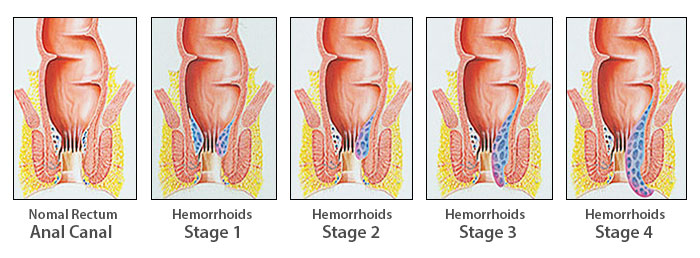Haemorrhoids can be inside the rectum (internal) and invisible, or outside the anus and visible (external).
Internal haemorrhoids can prolapse, resulting in their appearance outside the body, and external haemorrhoids may become thrombosed, meaning blood vessels within them have broken and given them a blue or purple appearance.
Below is a description of the different types and stages of haemorrhoids.
Internal Haemorrhoids
Identified through rectal bleeding and through Digital Reectal Examination (DRE), internal haemorrhoids exist only inside the rectum. They’re far enough inside that you can’t see them, and because there are no nerve endings that far inside the rectum, you can’t feel them either. Rectal bleeding due to haemorrhoids may not require much treatment, as they tend to heal up on their own or with haemorrhoids home remedies containing witch hazel and cayenne, among other natural ingredients.
External Haemorrhoids
External haemorrhoids are generally outside the anus and can be seen and felt. These are the kind of haemorrhoids most commonly treated with pain medications, as they are painful and uncomfortable. The reason you can feel these and not internal hemorrhoids is because the anus is ringed with sensitive nerve endings, making external hemorrhoids a serious source of pain. Most over-the-counter treatments seek to deal with the inflammation and pain of external haemorrhoids, allowing you to feel some relief as they recede and go away on their own. However, an herbal or natural remedy can provide some pain relief as it speeds up healing at the same time.
Prolapsed Haemorrhoids
An internal haemorrhoid can prolapse, meaning it leaves the rectum and protrudes outside the body. Because prolapsed haemorrhoids extend past the anus and outside the body, they put pressure on the nerve endings at the anus and can be very painful. If you fear you may have prolapsed internal hemorrhoids, you can recognize them by their feel and appearance: they are said to feel like soft, puffy pads of skin and look pinker than the skin of the anus. Often, these haemorrhoids will recede back into the rectum on their own, or they may be pushed gently back into the rectum.
Thrombosed Haemorrhoids
This type of haemorrhoid is an external hemorrhoid that has prolapsed and formed a blood clot. These are very painful and might need to be treated as soon as possible to avoid exacerbation and further discomfort. However, fortunately, many minor thrombosed hemorrhoids resolve themselves after a few weeks, so if the pain is not unbearable, a patient may be able to wait them out. These are often the ugliest forms of hemorrhoids, because they become swollen, may turn purple or blue, and may burst, especially during elimination of solids. Their appearance may be scary, but not necessarily indicative of any serious health concerns. It is best to avoid irritation of the area and keep it as clean as possible to allow healing.
The Four Stages of Hemorrhoids
Internal hemorrhoids are generally described by doctors in a four-stage system, depending on severity. These stages are used to describe any pain or discomfort, the location of the hemorrhoid, and potential treatment options. The descriptions can help you determine which, if any, of the internal hemorrhoids you may have and whether you should treat the hemorrhoid.
The hemorrhoid is recognized by some rectal bleeding, usually during elimination of solids. This bleeding can be exacerbated by exaggerated pushing during elimination or inadequate fiber intake in the diet, but is generally not indicative of a major problem. The hemorrhoid has not begun to prolapse externally.
The hemorrhoid at this stage has begun to prolapse and may bleed. Generally, hemorrhoids at stage 2 may retract back into the rectal cavity on their own, and are not a cause for concern. There may be some discomfort during elimination, and the appearance of rectal bleeding can be alarming, but often, stage 2 hemorrhoids are not dangerous or painful.
The hemorrhoid has prolapsed externally and can cause some pain, as it is touching the anal nerve endings. This occurs often when bearing down during elimination and may respond to manual reduction by gently massaging the hemorrhoid back into the rectum. In some cases, when kept clean and left alone, the hemorrhoid at this stage may simple retreat into the rectal cavity on its own, or it may require some hemorrhoids home treatment with herbal ingredients.
These are the most serious internal hemorrhoids; they cannot be manually reinserted into the rectum, and these are the most likely to become thrombosed. These are especially painful and generally require treatment through topical herbal remedies. If left alone, thrombosed prolapsed internal hemorrhoids may go away by themselves, but many patients choose to treat the hemorrhoid for reduction of their discomfort.
There are a number of ways to treat both hemorrhoid types, depending on their severity. They may go away on their own, or they may require a gentle herbal remedies. There are ways to prevent or lessen the severity of existing hemorrhoids, but if a hemorrhoid is persistent, painful, or results in consistently bloody stool or blood on the paper after elimination, you may want to try an herbal hemorrhoid treatment. Ingredients like Butcher’s Broom, cayenne, witch hazel, stone root, and white oak bark help reduce the pain and eliminate the presence of hemorrhoids, and they can all be found in the gentle, natural formula in Hemorrhoid Rescue.

